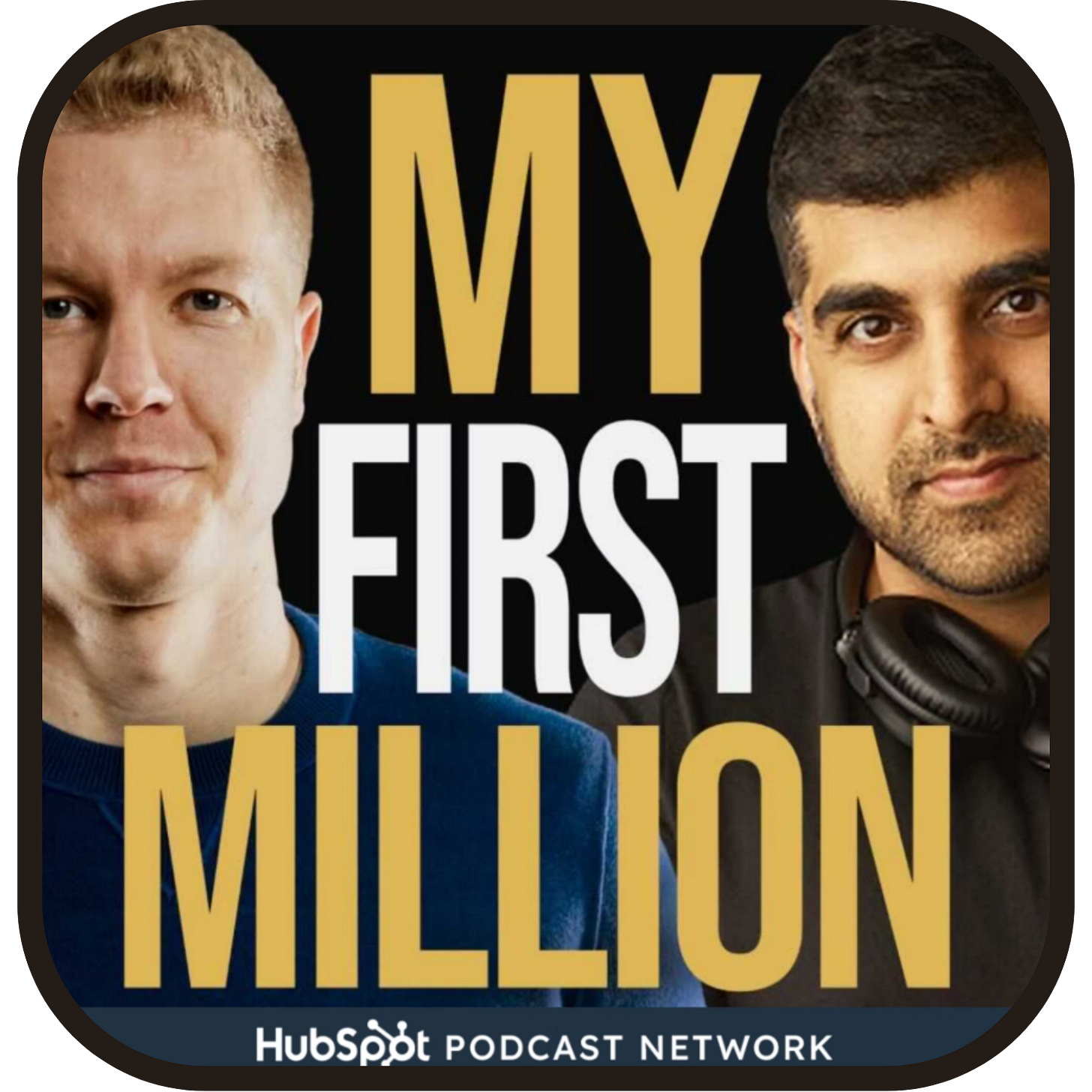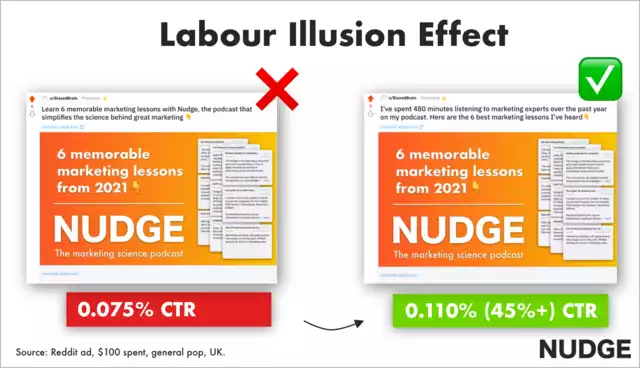🪄 The labor illusion effect, how to teach entrepreneurship, and more
I listen to 10 hours of podcasts a week, so you don’t have to.
This is the 22nd edition of Best 3 Podcasts of the Week 🥉🥈🥇, featuring My First Million, Startups For the Rest of Us, and Nudge.
What you need to know
📚 How to teach entrepreneurship
🥾 Default to bootstrapping
🪄 The labor illusion effect
BONUS experiment
📢 Phill Agnew’s Reddit ads
📚 How to teach entrepreneurship
🥉 Third place (3 min read vs 25 mins listening)
This one’s not a typical business roundup, so stay with me. Shaan answers a listener question every week as part of the series ‘One Question Friday’. He was asked ‘How are you going teach your kids to be entrepreneurial?’
He shared advice on how to teach kids entrepreneurship. Don’t worry if you don’t have kids. I’ll explain how this can help you in your career and how you can apply these ideas to inspire individuals and teams.
What they say
Shaan’s parenting plan
I want to install a mindset that things change and the world is not just the way it is. It has been constantly evolving and will change again.
The people who change it are people like you. They see the status quo and decide it can be better. I’ll tell them stories of people who have done this.
I’ll praise them specifically for figuring things out or bouncing back from failure, rather than just being smart or being good at X.
I’m going to teach them the skills of building, selling and investing. Specifically, giving them chances to become good at debate.
Then I’m going to give them experiences. The lemonade stand. Selling door to door. Travelling to third world countries. Sitting in on meetings. Flipping something on eBay.
I’m going to try to teach them ‘moral of the story’ exercises like the marshmallow challenge. It shows them the value in rapid prototyping, finding your key risks and assumptions, and not being afraid to fail.
I’m going to do all of those things and I’m not even going to mention the word entrepreneurship. It’s their choice about what they want to do. My job is to create an environment where they get exposed to it and build core foundational skills.
Shaan Puri
What I say
Why it matters: There are two types of people in this world. (1) People who are goal orientated, self motivated, and curious. (2) People who work the minimum amount in order to avoid getting sacked. I had a chat with a friend last week and we concluded ~90% of people fall into the second bucket of ‘quiet quitters’.
Why bring this up? Pretty much every kid falls into the first bucket. They’re excited to learn and to try new things. They relentlessly pursue what they want. So, what went wrong? At what point do most people transition from curious, motivated kids to disengaged adults? I don’t know. But, I believe people can rediscover the curiosity and determination of their youth.
Between the lines: I have a 1 year old girl and a 2 year old boy. They both epitomise the idiom ‘children are like sponges’. I have every intention to adopt Shaan’s techniques to teach entrepreneurship as a parent, but also as a manager. These ideas can improve engagement, team building, and encourage a growth mindset.
A personal favorites that I intend to try within the next couple of months is the marshmallow challenge. It encourages competitiveness and installs a bias to action that you can continue to nurture in the days and weeks after the exercise. Here’s a TED Talk by Tom Wujec with more details:
🥾 Default to bootstrapping
🥈 Second place (3 min read vs 27 mins listening)
Your default should be to bootstrap. Rob passionately believes the allure of venture capital is the wrong choice for most founders. After 615 episodes hosting Startups For the Rest of Us, he’s put together a list of scenarios that are the exception to the rule - where raising money does make sense.
What they say
The 7 times should you raise VC money
(1) If revenue is pushed down the line. Think of Facebook and how long they had to exist before they could monetize. The ad model is way down the line because you need to get traction first.
(2) If the market is winner takes all. Think of Uber and how quickly they had to move. Once everyone has the Uber app downloaded, drivers and the folks that need rides are unlikely to download another app.
(3) If you have a two sided marketplace. If you have reach into one or both of those sides, it’s a different story. If you have zero audience and you’re trying to do a two sided marketplace, bootstrapping this is very, very difficult.
(4) If you’re a hardware business. Hardware is really expensive. Is it easy? No. I would certainly think about raising funding if I were to do anything with big R&D expenses.
(5) If you’re taking a percentage of processed revenue. A good example of this is Stripe. Stripe takes 2.9% plus a transaction fee. That would be very difficult to bootstrap because of all the infrastructure you have to build upfront. That’s why Stripe went through YC and raised a quidrillion dollars.
(6) If you have massive per user costs. When Dropbox launched over a decade ago, they couldn’t use AWS because it was too expensive. They built their own data centres. There’s an upfront cost to buy those and store everything.
(7) If you need a network effect. This is mostly a two sided marketplace, but it can be a three sided marketplace. [You need to acquire users on the supply side and the demand side].
Rob Walling
What I say
Why it matters: Rob’s rule of thumb is:
1% of founders should raise from VCs
9% should explore other funding
90% should bootstrap their business
We’re indoctrinated to think that raising money is the best and only option for ambitious entrepreneurs. TechCrunch covers more stories about founders raising $10M than those who make $10M in profit.
All funding models have their pros and cons. We need more founders to talk about the drawbacks of raising from VCs and more bootstrapped founders to talk about their experience going solo - including the good, the bad, and the ugly. Better public discourse will help entrepreneurs make more informed decisions.
Between the lines: Do your homework. Figure out if your business should raise in the first place. Validate your idea on a shoestring budget before going all-in. On the rare occasion you should raise, figure out if this is what you want personally.
Do you want to relinquish control? Will you stop being your own boss?
What are your antigoals? Are you prepared to grow at all costs?
Are you financially better off if your company exits with VC funding compared to a smaller exit but with 100% ownership?
🪄 The labor illusion effect
🥇 First place (4 min read vs 25 mins listening)
Ladies and gentlemen, we have ourselves a golden combo. Phill Agnew and Sam Tatam have won back to back Best Business Podcast of the Week. This episode is all about the labor illusion effect.
What they say
The Aquafresh labor illusion
Aquafresh toothpaste wanted to showcase three benefits of using their toothpaste. Healthy gums. Strong teeth. Fresh breath.
Of course, they could have stuck those benefits on the product packaging and hoped people would read them.
But, they went one step further. They changed the product.
When you squeeze Aquafresh onto your toothbrush, you see three colors in your blob of toothpaste. Red, white, and blue. Those colors elude to the three benefits you’ll get. Healthy gums, strong teeth, and fresh breath.
You think ‘I must be getting multiple benefits here because I can see three different types of toothpaste on my brush.’
That’s not the case. Those colors are just dye. But, it works. It triggers the labor illusion. If they made the effort to put three types of toothpaste in, it must be doing a lot of good.
Phill Agnew
A word of warning
We can visually break up components of a product to make it feel like it’s doing more for us.
It doesn’t mean we can just create truths and visualize them. There’s lots of great research about how aware we are as consumers of organizations depicting labor when it’s not effective or efficient.
We need to be really careful with overclaiming or using these tools when the outcomes are not truthful.
If we know we have a winning formula, how can we help people to believe it? Sometimes, it can be just adding stripes to a toothpaste.
Sam Tatam
What I say
Why it matters: Evaluate your product and messaging through the labor illusion lens. What makes your product great? Can you highlight the effort that went into this? Test to see how you can improve conversion and/or your customer experience by tapping into this psychological phenomenon.
Between the lines: This newsletter always started with “save X hours listening.” However, this isn’t reflective of the true labor of listening to 10+ hours of podcasts that don’t make the cut. This episode has helped me tweak my messaging to include the total hours I listen to all podcasts, not the total hours of the top three podcasts.
BONUS experiment
Phill’s DIY experiment
I wanted to test it myself. Would operational transparency increase the number of listeners for this very show?
I created two different Reddit ads. The images for both ads were the same but the copy was slightly different.
The control read ‘Learn 6 memorable marketing lessons with Nudge, the podcast that simplifies the science behind great marketing.’
Then I had my operational transparency variant. This read ‘I spent 480 minutes listening to marketing experts over the past year on my podcast. Here are the 6 best marketing lessons I’ve heard.’
This highlighted the labor that went into creating that episode. I spent $100 promoting both of these posts and over 200,000 people saw the ads.
The results came back and they were pretty conclusive. People were 45% more likely to click on the operational transparency message.
I don’t class these ads as scientific. But, they’re building on evidence that’s out there. It showed for me that in marketing, the labor illusion can work to improve your campaigns and messages.
Phill Agnew
Most advice you read can be classed as ‘insight porn’. This is advice that hasn’t actually been practiced by the author (read Jakob Greenfeld’s post to better understand this phenomenon).
Phill actually tested the concept he discussed. I try to do this myself with the ‘What I say’ sections. I believe that if you apply the advice and frameworks you read, you genuinely learn and reap the benefits of your experiments. If you read newsletters, Twitter threads, and books, but don’t apply the learnings, you should view this as entertainment, not education.
Shoutouts
When I find newsletters, podcasts, or books worth sharing, I’ll feature them here:
Three Times Wiser is a popular newsletter that discusses big ideas, mental models, brain bugs and principles of wise thinking. It’s a quick read that helps 7,000 people (including me) to think creatively.
Note, these quotes were pulled at different points of the episode. Some sentences were left out to make the narrative clearer and more concise. Podup is not associated or affiliated with any podcast (unless otherwise stated). All roundups are independently written and do not imply any sponsorship or endorsement by the podcast.














